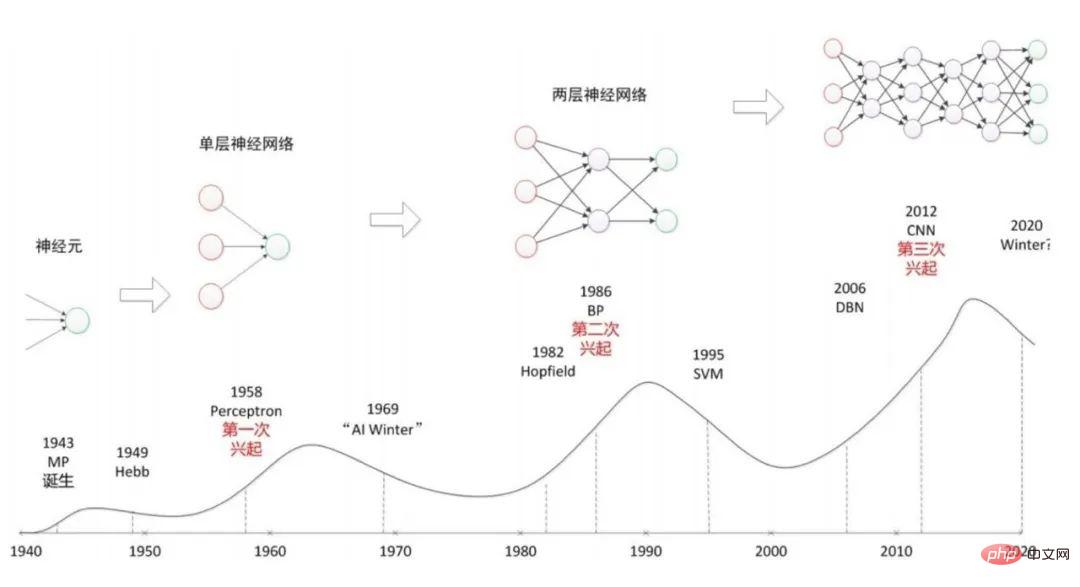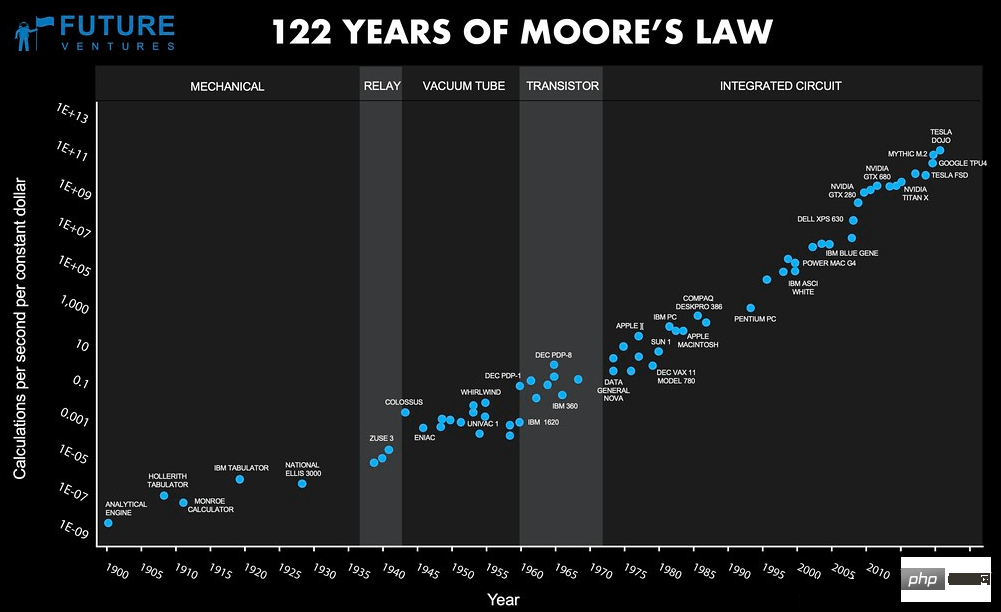 Technology peripherals
Technology peripherals
 AI
AI
 If it cannot support its future vision, will artificial intelligence once again usher in a 'winter'?
If it cannot support its future vision, will artificial intelligence once again usher in a 'winter'?
If it cannot support its future vision, will artificial intelligence once again usher in a 'winter'?
Since Alan Turing first raised the question "Can machines think?" in his seminal paper "Computing Machines and Intelligence" in 1950, the development of artificial intelligence has not been smooth sailing and has not yet been achieved. Its goal of “general artificial intelligence.”

However, the field has still made incredible progress, such as: IBM Deep Blue robot defeated the best chess player in the world, automatic The birth of the driving car, and Google DeepMind's AlphaGo defeating the world's best Go player... The current achievements demonstrate the best research and development results of the past 65 years.
It is worth noting that there was a well-documented “AI Winters” during this period, which almost completely overturned people’s early expectations for artificial intelligence.
One of the factors leading to the AI winter is the gap between hype and actual fundamental progress.
In the past few years, there has been speculation that another artificial intelligence winter may be coming. So what factors may trigger an artificial intelligence ice age?
Cyclic Fluctuations in Artificial Intelligence "AI Winter" refers to the public interest in artificial intelligence as the commercial and academic fields develop these technologies. A period of tapering investment.Artificial intelligence initially developed rapidly in the 1950s and 1960s. Although there have been many advances in artificial intelligence, they have mostly remained academic.
In the early 1970s, people’s enthusiasm for artificial intelligence began to fade, and this gloomy period lasted until around 1980.
During this artificial intelligence winter, activities dedicated to developing human-like intelligence for machines are starting to lack funding.

For eight weeks, they imagined a new field of research together.
As a young professor at Dartmouth University, John McCarthy coined the term “artificial intelligence” while designing a proposal for a seminar.
He believes that the workshop should explore the hypothesis that "every aspect of human learning or any other feature of intelligence can in principle be described so accurately that it can be described by machines to simulate it”.
At that meeting, researchers roughly sketched out what we know as artificial intelligence today.
It gave birth to the first camp of artificial intelligence scientists. "Symbolism" is an intelligent simulation method based on logical reasoning, also known as logicism, psychology school or computer school. Its principles are mainly physical symbol system assumptions and limited rationality principles, which have long been dominant in artificial intelligence research.
Their expert system reached its peak in the 1980s.
In the years after the conference, "connectionism" attributed human intelligence to the high-level activities of the human brain, emphasizing that intelligence is produced by a large number of simple units through complex interconnections and Results of parallel runs.
It starts from neurons and then studies neural network models and brain models, opening up another development path for artificial intelligence.
The two approaches have long been considered mutually exclusive, with both sides believing they are on the road to general artificial intelligence.
Looking back in the decades since that meeting, we can see that AI researchers’ hopes were often dashed, and that these setbacks did not stop them from developing AI.
Today, even though artificial intelligence is bringing revolutionary changes to industries and has the potential to disrupt the global labor market, many experts are still wondering whether today’s artificial intelligence applications have reached their limits. As Charles Choi describes in "Seven Revealed Ways AI Fail," today's deep learning systems Weaknesses are becoming increasingly apparent. However, researchers are not pessimistic about the future of artificial intelligence. We may be facing another AI winter in the near future. But this may be the moment when inspired artificial intelligence engineers finally lead us into the eternal summer of machine thinking. An article by Filip Piekniewski, an expert in computer vision and artificial intelligence, titled "AI Winter is Coming" has aroused heated discussion on the Internet. This article mainly criticizes the hype of deep learning, believing that this technology is far from revolutionary and is facing development bottlenecks. The interest of major companies in artificial intelligence is actually converging, and another winter of artificial intelligence may be coming. Since 1993, the field of artificial intelligence has made increasingly impressive progress. In 1997, IBM's Deep Blue system became the first to defeat world chess champion Gary. Kasparov's computer chess player. In 2005, a Stanford unmanned robot drove 131 miles on a desert road without touching a single step, winning the DARPA Autonomous Robot Challenge. In early 2016, Google’s DeepMind’s AlphaGo defeated the world’s best Go player. In the past twenty years, everything has changed. Especially with the booming development of the Internet, the artificial intelligence industry has enough pictures, sounds, videos and other types of data to train neural networks and apply them extensively. But the ever-expanding success of the deep learning field relies on increasing the number of layers in neural networks, and increasing the GPU time used to train them. The computing power required to train the largest artificial intelligence systems doubles every two years and then every 3-4 months, according to an analysis by artificial intelligence research firm OpenAI. Ichiban. As Neil C. Thompson and colleagues write in Diminishing Returns of Deep Learning, many researchers worry that the computational power of artificial intelligence Demand is on an unsustainable trajectory. A common problem faced by early artificial intelligence research was a severe lack of computing power. They were limited by hardware rather than human intelligence or ability. Over the past 25 years, as computing power has increased dramatically, so have our advances in artificial intelligence. However, in the face of the surging massive data and increasingly complex algorithms, 20ZB of new data are added globally every year, and the demand for AI computing power increases 10 times every year. This rate has far exceeded Moore's Law is about the doubling cycle of performance. We are approaching the theoretical physical limit of the number of transistors that can be installed on a chip. For example, Intel is slowing down the pace of launching new chip manufacturing technologies because it is difficult to continue to reduce the size of transistors while saving costs. In short, the end of Moore's Law is approaching. Photo source: Ray Kurzwell, DFJ There are some short-term solutions that will ensure the continued growth of computing power and thus the advancement of artificial intelligence. For example, in mid-2017, Google announced that it had developed a specialized artificial intelligence chip called "Cloud TPU" that is optimized for the training and execution of deep neural networks. Amazon develops its own chip for Alexa (artificial intelligence personal assistant). At the same time, there are currently many startups trying to adapt chip designs for specialized artificial intelligence applications. However, these are only short-term solutions. What happens when we run out of options to optimize traditional chip design? Will we see another AI winter? The answer is yes, unless quantum computing can surpass classical computing and find a more solid answer. But until now, a quantum computer that can achieve "quantum hegemony" and is more efficient than a traditional computer does not yet exist. If we reach the limit of traditional computing power before the arrival of true "quantum supremacy", I am afraid that there will be another winter of artificial intelligence in the future. The problems that artificial intelligence researchers are grappling with are increasingly complex and pushing us toward realizing Alan Turing’s vision of artificial general artificial intelligence. However, there is still a lot of work to be done. At the same time, we will be very unlikely to realize the full potential of artificial intelligence without the help of quantum computing. No one can say for sure whether an AI winter is coming. However, it is important to be aware of the potential risks and pay close attention to the signs so that we can be prepared when it does happen. Will the artificial intelligence winter come?

The above is the detailed content of If it cannot support its future vision, will artificial intelligence once again usher in a 'winter'?. For more information, please follow other related articles on the PHP Chinese website!

Hot AI Tools

Undresser.AI Undress
AI-powered app for creating realistic nude photos

AI Clothes Remover
Online AI tool for removing clothes from photos.

Undress AI Tool
Undress images for free

Clothoff.io
AI clothes remover

AI Hentai Generator
Generate AI Hentai for free.

Hot Article

Hot Tools

Notepad++7.3.1
Easy-to-use and free code editor

SublimeText3 Chinese version
Chinese version, very easy to use

Zend Studio 13.0.1
Powerful PHP integrated development environment

Dreamweaver CS6
Visual web development tools

SublimeText3 Mac version
God-level code editing software (SublimeText3)

Hot Topics
 1378
1378
 52
52
 Bytedance Cutting launches SVIP super membership: 499 yuan for continuous annual subscription, providing a variety of AI functions
Jun 28, 2024 am 03:51 AM
Bytedance Cutting launches SVIP super membership: 499 yuan for continuous annual subscription, providing a variety of AI functions
Jun 28, 2024 am 03:51 AM
This site reported on June 27 that Jianying is a video editing software developed by FaceMeng Technology, a subsidiary of ByteDance. It relies on the Douyin platform and basically produces short video content for users of the platform. It is compatible with iOS, Android, and Windows. , MacOS and other operating systems. Jianying officially announced the upgrade of its membership system and launched a new SVIP, which includes a variety of AI black technologies, such as intelligent translation, intelligent highlighting, intelligent packaging, digital human synthesis, etc. In terms of price, the monthly fee for clipping SVIP is 79 yuan, the annual fee is 599 yuan (note on this site: equivalent to 49.9 yuan per month), the continuous monthly subscription is 59 yuan per month, and the continuous annual subscription is 499 yuan per year (equivalent to 41.6 yuan per month) . In addition, the cut official also stated that in order to improve the user experience, those who have subscribed to the original VIP
 Context-augmented AI coding assistant using Rag and Sem-Rag
Jun 10, 2024 am 11:08 AM
Context-augmented AI coding assistant using Rag and Sem-Rag
Jun 10, 2024 am 11:08 AM
Improve developer productivity, efficiency, and accuracy by incorporating retrieval-enhanced generation and semantic memory into AI coding assistants. Translated from EnhancingAICodingAssistantswithContextUsingRAGandSEM-RAG, author JanakiramMSV. While basic AI programming assistants are naturally helpful, they often fail to provide the most relevant and correct code suggestions because they rely on a general understanding of the software language and the most common patterns of writing software. The code generated by these coding assistants is suitable for solving the problems they are responsible for solving, but often does not conform to the coding standards, conventions and styles of the individual teams. This often results in suggestions that need to be modified or refined in order for the code to be accepted into the application
 Can fine-tuning really allow LLM to learn new things: introducing new knowledge may make the model produce more hallucinations
Jun 11, 2024 pm 03:57 PM
Can fine-tuning really allow LLM to learn new things: introducing new knowledge may make the model produce more hallucinations
Jun 11, 2024 pm 03:57 PM
Large Language Models (LLMs) are trained on huge text databases, where they acquire large amounts of real-world knowledge. This knowledge is embedded into their parameters and can then be used when needed. The knowledge of these models is "reified" at the end of training. At the end of pre-training, the model actually stops learning. Align or fine-tune the model to learn how to leverage this knowledge and respond more naturally to user questions. But sometimes model knowledge is not enough, and although the model can access external content through RAG, it is considered beneficial to adapt the model to new domains through fine-tuning. This fine-tuning is performed using input from human annotators or other LLM creations, where the model encounters additional real-world knowledge and integrates it
 Seven Cool GenAI & LLM Technical Interview Questions
Jun 07, 2024 am 10:06 AM
Seven Cool GenAI & LLM Technical Interview Questions
Jun 07, 2024 am 10:06 AM
To learn more about AIGC, please visit: 51CTOAI.x Community https://www.51cto.com/aigc/Translator|Jingyan Reviewer|Chonglou is different from the traditional question bank that can be seen everywhere on the Internet. These questions It requires thinking outside the box. Large Language Models (LLMs) are increasingly important in the fields of data science, generative artificial intelligence (GenAI), and artificial intelligence. These complex algorithms enhance human skills and drive efficiency and innovation in many industries, becoming the key for companies to remain competitive. LLM has a wide range of applications. It can be used in fields such as natural language processing, text generation, speech recognition and recommendation systems. By learning from large amounts of data, LLM is able to generate text
 To provide a new scientific and complex question answering benchmark and evaluation system for large models, UNSW, Argonne, University of Chicago and other institutions jointly launched the SciQAG framework
Jul 25, 2024 am 06:42 AM
To provide a new scientific and complex question answering benchmark and evaluation system for large models, UNSW, Argonne, University of Chicago and other institutions jointly launched the SciQAG framework
Jul 25, 2024 am 06:42 AM
Editor |ScienceAI Question Answering (QA) data set plays a vital role in promoting natural language processing (NLP) research. High-quality QA data sets can not only be used to fine-tune models, but also effectively evaluate the capabilities of large language models (LLM), especially the ability to understand and reason about scientific knowledge. Although there are currently many scientific QA data sets covering medicine, chemistry, biology and other fields, these data sets still have some shortcomings. First, the data form is relatively simple, most of which are multiple-choice questions. They are easy to evaluate, but limit the model's answer selection range and cannot fully test the model's ability to answer scientific questions. In contrast, open-ended Q&A
 Five schools of machine learning you don't know about
Jun 05, 2024 pm 08:51 PM
Five schools of machine learning you don't know about
Jun 05, 2024 pm 08:51 PM
Machine learning is an important branch of artificial intelligence that gives computers the ability to learn from data and improve their capabilities without being explicitly programmed. Machine learning has a wide range of applications in various fields, from image recognition and natural language processing to recommendation systems and fraud detection, and it is changing the way we live. There are many different methods and theories in the field of machine learning, among which the five most influential methods are called the "Five Schools of Machine Learning". The five major schools are the symbolic school, the connectionist school, the evolutionary school, the Bayesian school and the analogy school. 1. Symbolism, also known as symbolism, emphasizes the use of symbols for logical reasoning and expression of knowledge. This school of thought believes that learning is a process of reverse deduction, through existing
 SOTA performance, Xiamen multi-modal protein-ligand affinity prediction AI method, combines molecular surface information for the first time
Jul 17, 2024 pm 06:37 PM
SOTA performance, Xiamen multi-modal protein-ligand affinity prediction AI method, combines molecular surface information for the first time
Jul 17, 2024 pm 06:37 PM
Editor | KX In the field of drug research and development, accurately and effectively predicting the binding affinity of proteins and ligands is crucial for drug screening and optimization. However, current studies do not take into account the important role of molecular surface information in protein-ligand interactions. Based on this, researchers from Xiamen University proposed a novel multi-modal feature extraction (MFE) framework, which for the first time combines information on protein surface, 3D structure and sequence, and uses a cross-attention mechanism to compare different modalities. feature alignment. Experimental results demonstrate that this method achieves state-of-the-art performance in predicting protein-ligand binding affinities. Furthermore, ablation studies demonstrate the effectiveness and necessity of protein surface information and multimodal feature alignment within this framework. Related research begins with "S
 Laying out markets such as AI, GlobalFoundries acquires Tagore Technology's gallium nitride technology and related teams
Jul 15, 2024 pm 12:21 PM
Laying out markets such as AI, GlobalFoundries acquires Tagore Technology's gallium nitride technology and related teams
Jul 15, 2024 pm 12:21 PM
According to news from this website on July 5, GlobalFoundries issued a press release on July 1 this year, announcing the acquisition of Tagore Technology’s power gallium nitride (GaN) technology and intellectual property portfolio, hoping to expand its market share in automobiles and the Internet of Things. and artificial intelligence data center application areas to explore higher efficiency and better performance. As technologies such as generative AI continue to develop in the digital world, gallium nitride (GaN) has become a key solution for sustainable and efficient power management, especially in data centers. This website quoted the official announcement that during this acquisition, Tagore Technology’s engineering team will join GLOBALFOUNDRIES to further develop gallium nitride technology. G



